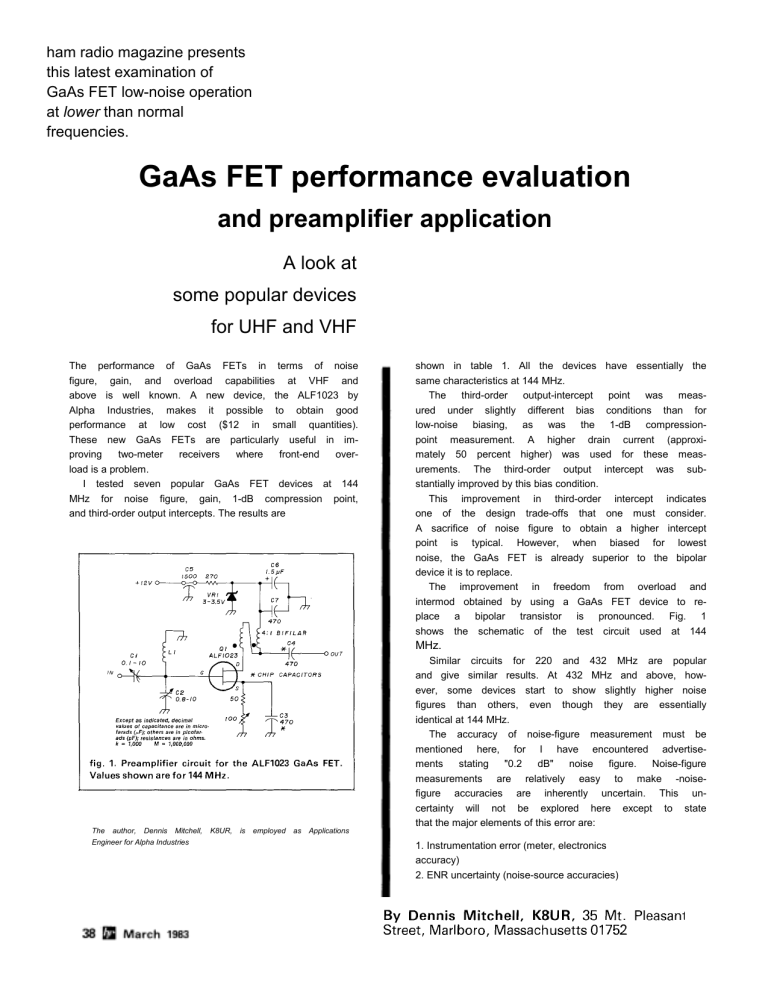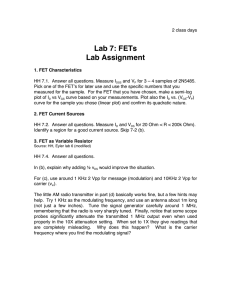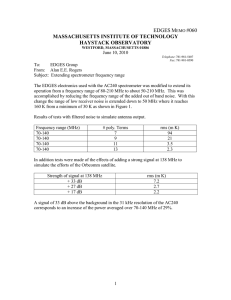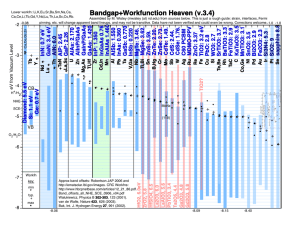OCR Document

ham radio magazine presents this latest examination of
GaAs FET low-noise operation at lower than normal frequencies.
GaAs FET performance evaluation
and preamplifier application
A look at
some popular devices for UHF and VHF
The performance of GaAs FETs in terms of noise figure, gain, and overload capabilities at VHF and above is well known. A new device, the ALF1023 by
Alpha Industries, makes it possible to obtain good performance at low cost ($12 in small quantities).
These new GaAs FETs are particularly useful in improving two-meter receivers where front-end overload is a problem.
I tested seven popular GaAs FET devices at 144
MHz for noise figure, gain, 1-dB compression point, and third-order output intercepts. The results are
The author, Dennis Mitchell, K8UR, is employed as Applications
Engineer for Alpha Industries shown in table 1. All the devices have essentially the same characteristics at 144 MHz.
The third-order output-intercept point was measured under slightly different bias conditions than for low-noise biasing, as was the 1-dB compressionpoint measurement. A higher drain current (approximately 50 percent higher) was used for these measurements. The third-order output intercept was substantially improved by this bias condition.
This improvement in third-order intercept indicates one of the design trade-offs that one must consider.
A sacrifice of noise figure to obtain a higher intercept point is typical. However, when biased for lowest noise, the GaAs FET is already superior to the bipolar device it is to replace.
The improvement in freedom from overload and intermod obtained by using a GaAs FET device to replace a bipolar transistor is pronounced. Fig. 1 shows the schematic of the test circuit used at 144
MHz.
Similar circuits for 220 and 432 MHz are popular and give similar results. At 432 MHz and above, however, some devices start to show slightly higher noise figures than others, even though they are essentially identical at 144 MHz.
The accuracy of noise-figure measurement must be mentioned here, for I have encountered advertisements stating "0.2 dB" noise figure. Noise-figure measurements are relatively easy to make -noisefigure accuracies are inherently uncertain. This uncertainty will not be explored here except to state that the major elements of this error are:
1. Instrumentation error (meter, electronics accuracy)
2. ENR uncertainty (noise-source accuracies)
3. Mismatch uncertainties (VSWR between source and device)
4. Second-stage uncertainties
I did not verify the noise-figure claims for many
Amateur-band preamplifiers tested.
The system used for the gain and noise-figure measurements listed in table 1 was an HP 346B
Noise source and HP 8970A Noise-Figure Meter with a typical root-sum-of-squares uncertainty of +/0.23
dB at 144 MHz.
Fig. 2 shows a plot of the S11 and S22 characteristics of the ALF1023 GaAs FET from 100 to 8000 MHz.
Fig. 3 clearly depicts the ALF1023 dc and RF performance. Fig. 3a is a curve trace showing Ids versus Vgs with an Idss of 50 mA. Fig. 3b illustrates the trade-off possible between noise figure and intercept point for given values of drain current.



